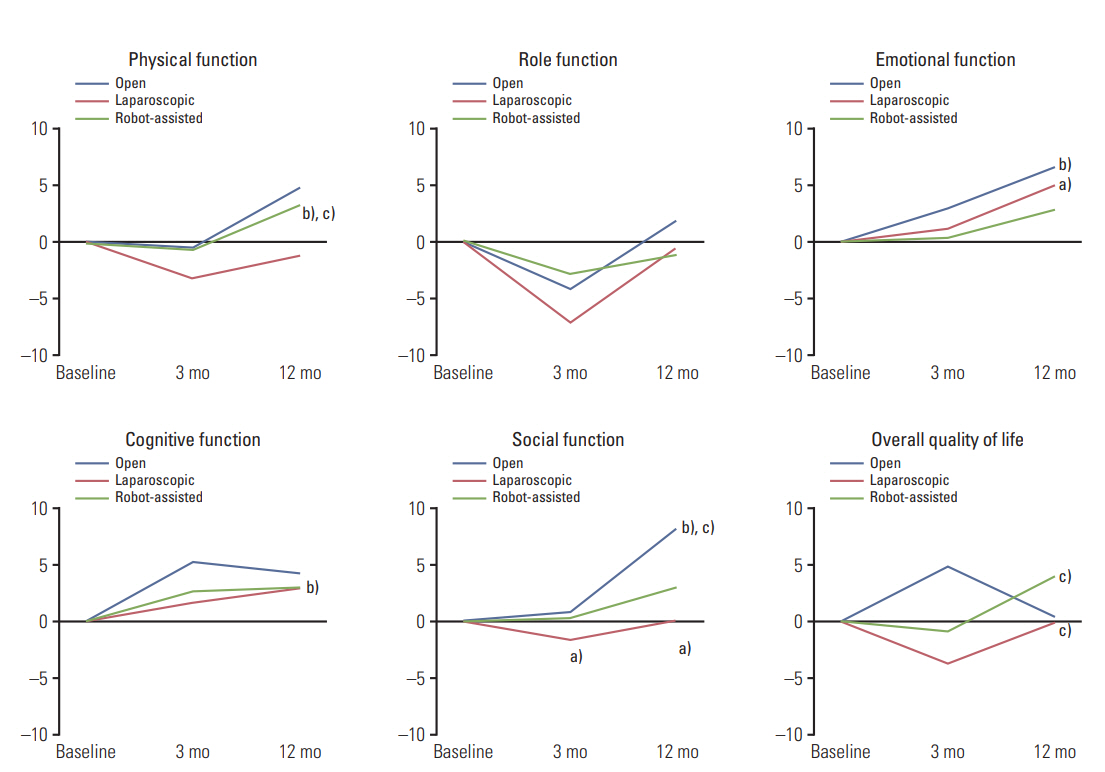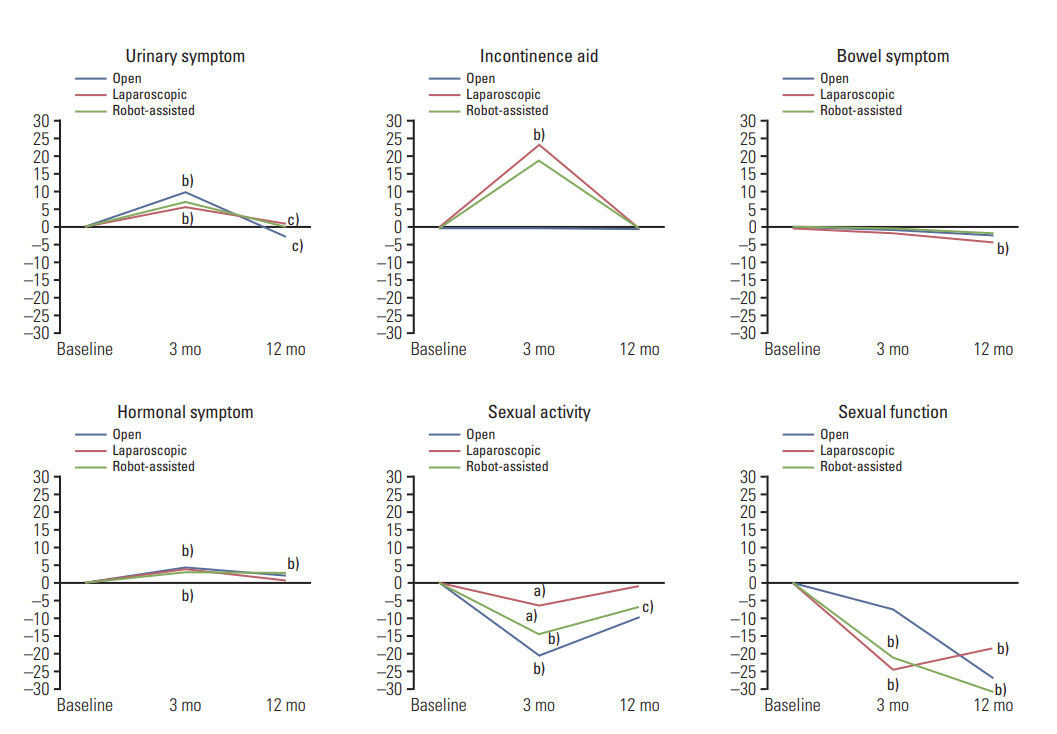Cancer Res Treat.
2019 Apr;51(2):556-567. 10.4143/crt.2018.221.
Health-Related Quality of Life Changes in Prostate Cancer Patients after Radical Prostatectomy: A Longitudinal Cohort Study
- Affiliations
-
- 1Department of Family Medicine, Samsung Medical Center, Seoul, Korea.
- 2Department of Digital Health, SAIHST, Sungkyunkwan University, Seoul, Korea.
- 3Department of Urology, Kyung Hee University School of Medicine, Seoul, Korea.
- 4Department of Urology, School of Medicine, Kyungpook National University, Daegu, Korea.
- 5Department of Urology, Chungbuk National University College of Medicine, Cheongju, Korea.
- 6Department of Urology, Pusan National University Yangsan Hospital, Yangsan, Korea.
- 7Department of Urology, Wonkwang University School of Medicine, Iksan, Korea.
- 8Department of Urology, Chonnam National University Medical School, Gwangju, Korea.
- 9College of Medicine/Graduate School of Health Science Business Convergence, Chungbuk National University, Cheongju, Korea.
- 10Division of Cancer Policy and Management, National Cancer Control Research Institute, National Cancer Center, Goyang, Korea.
- 11Department of Urology, Eulji University Hospital, Eulji University School of Medicine, Daejeon, Korea. jspark.uro@gmail.com
- KMID: 2464403
- DOI: http://doi.org/10.4143/crt.2018.221
Abstract
- PURPOSE
Health-related quality of life (HRQOL) information related to radical prostatectomy (RP) is valuable for prostate cancer (PC) patients needing to make treatment decisions. We aimed to investigate HRQOL change in PC patients who underwent three types of RP (open, laparoscopic, or robotic) and compared their HRQOL with that of general population.
MATERIALS AND METHODS
Patients were prospectively recruited between October 2014 and December 2015. European Organization for Research and Treatment of Cancer Quality-of-Life Questionnaire (EORTC QLQ-C30) and PC-specific module (PR25) were administered before surgery (baseline) and at postoperative 3 and 12 months. At each time point, HRQOL was compared, and a difference of 10 out of 0-100 scale was considered clinically significant.
RESULTS
Among 258 screened patients, 209 (41 open, 63 laparoscopic, and 105 robotic surgeries) were included. Compared to baseline, physical, emotional, and cognitive functioning improved at 12 months. Role functioning worsened at 3 months, but recovered to baseline at 12 months. Pain, insomnia, diarrhea, and financial difficulties also significantly improved at 12 months. Most PR25 scales excluding bowel symptoms deteriorated at 3 months. Urinary symptoms and incontinence aid recovered at 12 months, whereas sexual activity and sexual function remained poor at 12 months. Clinically meaningful differences in HRQOL were not observed according to RP modalities. Compared to the general population, physical and role functioning were significantly lower at 3 months, but recovered by 12 months. Social functioning did not recover.
CONCLUSION
Most HRQOL domains showed recovery within 12 months after RP, excluding sexual functioning and social functioning. Our findings may guide patients considering surgical treatment for PC.
MeSH Terms
Figure
Cited by 1 articles
-
The Effect of Post-prostatectomy Urinary Incontinence on Health-related Quality of Life in Patients with Prostate Cancer
Jeong Hyun Kim, Yeon Soo Jang, Young Deuk Choi, Eui Geum Oh
Korean J Adult Nurs. 2019;31(3):293-302. doi: 10.7475/kjan.2019.31.3.293.
Reference
-
References
1. Siegel R, Ma J, Zou Z, Jemal A. Cancer statistics, 2014. CA Cancer J Clin. 2014; 64:9–29.
Article2. Jung KW, Won YJ, Oh CM, Kong HJ, Lee DH, Lee KH, et al. Cancer statistics in Korea: incidence, mortality, survival, and prevalence in 2014. Cancer Res Treat. 2017; 49:292–305.
Article3. Moore AL, Dimitropoulou P, Lane A, Powell PH, Greenberg DC, Brown CH, et al. Population-based prostate-specific antigen testing in the UK leads to a stage migration of prostate cancer. BJU Int. 2009; 104:1592–8.
Article4. Park J, Suh B, Shin DW, Hong JH, Ahn H. Changing patterns of primary treatment in Korean men with prostate cancer over 10 years: a nationwide population based study. Cancer Res Treat. 2016; 48:899–906.
Article5. Bergius S, Torvinen S, Muhonen T, Roine RP, Sintonen H, Taari K. Health-related quality of life among prostate cancer patients: real-life situation at the beginning of treatment. Scand J Urol. 2017; 51:13–9.
Article6. Tewari A, Sooriakumaran P, Bloch DA, Seshadri-Kreaden U, Hebert AE, Wiklund P. Positive surgical margin and perioperative complication rates of primary surgical treatments for prostate cancer: a systematic review and meta-analysis comparing retropubic, laparoscopic, and robotic prostatectomy. Eur Urol. 2012; 62:1–15.
Article7. Tewari A, Srivasatava A, Menon M. Members of the VIP Team. A prospective comparison of radical retropubic and robotassisted prostatectomy: experience in one institution. BJU Int. 2003; 92:205–10.
Article8. Anastasiadis AG, Salomon L, Katz R, Hoznek A, Chopin D, Abbou CC. Radical retropubic versus laparoscopic prostatectomy: a prospective comparison of functional outcome. Urology. 2003; 62:292–7.
Article9. Frank SJ, Pisters LL, Davis J, Lee AK, Bassett R, Kuban DA. An assessment of quality of life following radical prostatectomy, high dose external beam radiation therapy and brachytherapy iodine implantation as monotherapies for localized prostate cancer. J Urol. 2007; 177:2151–6.
Article10. Sanda MG, Dunn RL, Michalski J, Sandler HM, Northouse L, Hembroff L, et al. Quality of life and satisfaction with outcome among prostate-cancer survivors. N Engl J Med. 2008; 358:1250–61.
Article11. Kim S, Shin DW, Yang HK, Kim SY, Ko YJ, Cho B, et al. Public perceptions on cancer incidence and survival: a nation-wide survey in Korea. Cancer Res Treat. 2016; 48:775–88.
Article12. Yoo H, Shin DW, Jeong A, Kim SY, Yang HK, Kim JS, et al. Perceived social support and its impact on depression and health-related quality of life: a comparison between cancer patients and general population. Jpn J Clin Oncol. 2017; 47:728–34.
Article13. Aaronson NK, Ahmedzai S, Bergman B, Bullinger M, Cull A, Duez NJ, et al. The European Organization for Research and Treatment of Cancer QLQ-C30: a quality-of-life instrument for use in international clinical trials in oncology. J Natl Cancer Inst. 1993; 85:365–76.
Article14. Yun YH, Park YS, Lee ES, Bang SM, Heo DS, Park SY, et al. Validation of the Korean version of the EORTC QLQ-C30. Qual Life Res. 2004; 13:863–8.
Article15. van Andel G, Bottomley A, Fossa SD, Efficace F, Coens C, Guerif S, et al. An international field study of the EORTC QLQ-PR25: a questionnaire for assessing the health-related quality of life of patients with prostate cancer. Eur J Cancer. 2008; 44:2418–24.
Article16. Park J, Shin DW, Yun SJ, Park SW, Jeon SS, Kwak C, et al. Cross-cultural application of the Korean version of the European Organization for Research and Treatment of Cancer Quality of Life Questionnaire for patients with prostate cancer: EORTC QLQ-PR25. Oncology. 2013; 85:299–305.17. Rubin DB. On principles for modeling propensity scores in medical research. Pharmacoepidemiol Drug Saf. 2004; 13:855–7.
Article18. Maringwa J, Quinten C, King M, Ringash J, Osoba D, Coens C, et al. Minimal clinically meaningful differences for the EORTC QLQ-C30 and EORTC QLQ-BN20 scales in brain cancer patients. Ann Oncol. 2011; 22:2107–12.
Article19. Bach P, Doring T, Gesenberg A, Mohring C, Goepel M. Quality of life of patients after retropubic prostatectomy: pre- and postoperative scores of the EORTC QLQ-C30 and QLQ-PR25. Health Qual Life Outcomes. 2011; 9:93.20. Litwin MS, Melmed GY, Nakazon T. Life after radical prostatectomy: a longitudinal study. J Urol. 2001; 166:587–92.
Article21. Resnick MJ, Koyama T, Fan KH, Albertsen PC, Goodman M, Hamilton AS, et al. Long-term functional outcomes after treatment for localized prostate cancer. N Engl J Med. 2013; 368:436–45.
Article22. Lepore SJ, Helgeson VS, Eton DT, Schulz R. Improving quality of life in men with prostate cancer: a randomized controlled trial of group education interventions. Health Psychol. 2003; 22:443–52.
Article23. Montorsi F, Brock G, Stolzenburg JU, Mulhall J, Moncada I, Patel HR, et al. Effects of tadalafil treatment on erectile function recovery following bilateral nerve-sparing radical prostatectomy: a randomised placebo-controlled study (REACTT). Eur Urol. 2014; 65:587–96.
Article24. Roth AJ, Weinberger MI, Nelson CJ. Prostate cancer: psychosocial implications and management. Future Oncol. 2008; 4:561–8.
Article25. van der Poel HG, Tillier C, de Blok WM, Acar C, van Muilekom EH, van den Bergh RC. Interview-based versus questionnaire-based quality of life outcomes before and after prostatectomy. J Endourol. 2013; 27:1411–6.
Article26. Parahoo K, McDonough S, McCaughan E, Noyes J, Semple C, Halstead EJ, et al. Psychosocial interventions for men with prostate cancer: a Cochrane systematic review. BJU Int. 2015; 116:174–83.
Article27. Zenger M, Hinz A, Stolzenburg JU, Rabenalt R, Schwalenberg T, Schwarz R. Health-related quality of life of prostate cancer patients compared to the general German population: age-specific results. Urol Int. 2009; 83:166–70.
Article28. Bestmann B, Loetters C, Diemer T, Weidner W, Kuchler T, Rohde V. Prostate-specific symptoms of prostate cancer in a German general population. Prostate Cancer Prostatic Dis. 2007; 10:52–9.
Article29. Peuckmann V, Ekholm O, Rasmussen NK, Moller S, Groenvold M, Christiansen P, et al. Health-related quality of life in long-term breast cancer survivors: nationwide survey in Denmark. Breast Cancer Res Treat. 2007; 104:39–46.
Article30. Gotay CC, Muraoka MY. Quality of life in long-term survivors of adult-onset cancers. J Natl Cancer Inst. 1998; 90:656–67.
Article
- Full Text Links
- Actions
-
Cited
- CITED
-
- Close
- Share
- Similar articles
-
- Letter to the editor: Changes in health-related quality of life after radical prostatectomy for prostate cancer: A longitudinal cohort study in Korea
- Changes in health-related quality of life after radical prostatectomy for prostate cancer: A longitudinal cohort study in Korea
- Radical Prostatectomy
- Health-related Quality of Life and Depression after Radical Prostatectomy or Hormonal Therapy
- A Case of No Residual Cancer in Radical Prostatectomy Specimens Despite Biopsy-proven Prostate Cancer





